|
Information Leaflet No.2
SCOTTISH
CREST BADGES
INTRODUCTION
Much confusion exists
about the meaning, use and entitlement to wear Scottish Crest Badges,
and it is constantly increased by well—meaning but ill—informed
explanations. This leaflet is authoritative in setting out the main
facts. Even the popular name "Clan Crest" is a misnomer, as
there is no such thing as a "Clan" Crest. The Crest is the
exclusively personal property of the Clan Chief, and it is fully
protected to him by the law in Scotland. The circumstances in which it
may be worn by his clansmen are set out hereafter. But, first, four
brief definitions of the technical terms are necessary.
1. DEFINITIONS
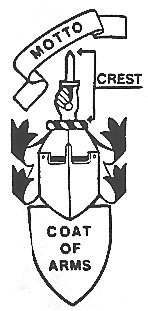 |
(a) THE
CREST
When a coat of Arms is granted by
the Sovereign through Her Majesty’s Lord Lyon King of Arms,
the Grant of Arms document shows the coat of Arms on a Shield.
Above the Shield is placed a conventional helmet, and on top of
the helmet is shown an additional. device called the CREST,
accompanied by the owner’s Motto on a conventional scroll. It
is impossible to own a Crest without first owning a coat of
Arms, shown on the Shield, as the Crest is an adjunct to the
coat of Arms. Sometimes an additional Motto or Slogan is
granted, which may correctly appear on the Clansman’s bonnet
badge as an alternative to the first Motto. |
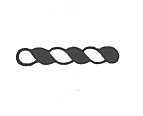 |
(b) THE
WREATH
Between the Crest and the helmet
usually appears a WREATH of twisted cloth of alternate twists of
the owner’s "Livery colours", on which the Crest
stands. When the Crest is shown by itself, without the coat of
Arms, this WREATH is always shown beneath it to indicate that it
is a heraldic Crest and not merely a depiction of some object or
other. It is usually shown as a sort of straight sausage, with
six twists. |
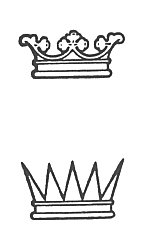 |
(c) THE
CREST CORONET
Sometimes a coronet appears
instead of a Wreath, and serves the same function. This is
usually a CREST CORONET, similar to that of a Duke but showing
only one and two halves of strawberry leaves on its upper rim
instead of a Duke’s three and two halves, and without the
velvet and ermine cap which fits inside a ducal coronet. Many
Clan Chiefs have Crest Coronets beneath their Crests instead of
Wreaths. Sometimes Crests have different forms of coronets
beneath them instead of Wreaths, usually the form known the
"antique crown" which is an "open" crown
(having no arches over, it) showing on its upper rim three and
two halves of tapering triangular spikes. |
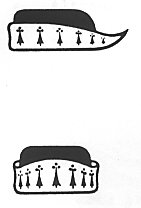 |
(d) THE
CHAPEAU
Sometimes a heraldic CHAPEAU
replaces the Wreath, or occasionally appears between the Wreath
and the Crest. This is a conventional depiction of a velvet hat,
flat on top and lined with ermine fur which shows on the turned—up
brim of the hat. The edge of the brim is sometimes shown
scalloped, sometimes straight. The shape of the hat varies with
the artist who drew it; usually a side view is shown, when the
hat looks rather like a Glengarry, with the brim tapering to a
point at one end; a front view looks like a pillbox, with the
brim turned up across it. Nowadays the Chapeau, which indicates
its owner’s baronial rank, usually appears beneath the helmet
instead of beneath the Crest. |
NOTE: The choice and use of Wreath, Crest
Coronet or Chapeau is NOT a matter of the owner’s whim, but is part of
his Grant of Arms where they are stipulated. They may ONLY be used when
they have been so granted by the Lord Lyon King of Arms.
2. RIGHTS
Any Scot who has recorded Arms and Crest
in the Public Register of All Arms and Bearings in Scotland ("Lyon
Register" for short) has the right to wear his Crest as a badge in
various particular forms (see Section 5). NO ONE ELSE AT ALL may wear a
badge of the Crest that such an "armiger" has recorded as his
own, and this is a matter of law. The Arms and Crest are protected for
their owner by the Laws of Arms in Scotland, and illegal infringement of
his sole rights can bring prosecution, a fine and confiscation of the
property marked with the rightful owner’s Arms and/or Crest. Such a
prosecution is conducted entirely at the expense of the Crown, and so
the owners of Arms invoke it very freely and at no cost to themselves.
In Scotland ALL Arms and Crests are
PERSONAL. There is NO SUCH THING as a "Family" coat of Arms or
Crest. Though the Arms or Crest may be borne by SUCCESSIVE members of a
family, they are personal to each in turn. The rules of the inheritance
of Arms and Crests are legal and strict.
3. SAME NAME
When a person has recorded Arms and Crest
in the Lyon Register, it is strictly NOT open to anyone else of the same
surname to use his Crest. This is an infringement of the owner’s legal
rights, for which he may ask the Procurator Fiscal of the Court of the
Lord Lyon to prosecute the offender.
Ownership of Arms and Crest is PERSONAL,
and is NOT extended to others of the same surname except in the cases
outlined in Section 5 hereafter.
4. CHIEFS OF CLANS AND HEADS OR "REPRESENTERS"
OF FAMILIES
Chiefs are heads of very large
"extended" families, including all of the same surname and
probably many "septs" as well. "Septs" are large
extended families (i.e. including distant cousins and connections)
within a Clan but bearing different surnames from tha Clan, usually the
result of arbitrary fixing of surnames about the 17th century, prior to
which surnames were not general in their modern form in Scotland. Fairly
comprehensive lists of sept names and their Clans are given in "The
Clans, Septs and Regiments of the Scottish Highlands" by Frank Adam
and Sir Thomas Innes of Learney, 6th ed.196O, in two extensive
appendices, and also in "The Official Tartan Map" by John
Telfer Dunbar and Don Pottinger, Hamish Hamilton 1976.
Heads or REPRESENTERS of families are
those whose claims to be the genealogically senior living persons of
their surnames have been Officially Recognised by the Lord Lyon King of
Arms, and are recorded as such in the Lyon Register. They are usually
heads of extended families too sirall in number to claim to be
"Clans". But they can be small or Lowland too ;
"Clan" simply means "family", in the broad sense.
5. WEARING AND FORM OF CREST BADGES
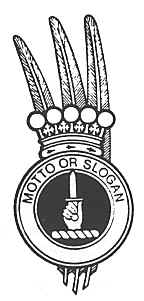 |
(a)
CHIEFS OF CLANS
Chiefs have the right to wear
their Crests as badges
EITHER simpliciter, without the
accompaniment of circlet, motto or feathers behind the badge.
OR as is more usual, surrounded
with a plain circlet inscribed with his Motto or Slogan, NOT a
strap—and—buckle which is for clansmen; and, if they choose,
with THREE eagle’s feathers in silver behind the circlet.
If the Chief is also a Peer of
the Realm, he may correctly add his appropriate coronet of rank
on top of the circlet, but this is a matter of his personal
choice. |
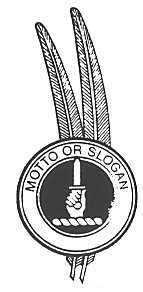 |
(b)
CHIEFTAINS
i.e. Heads of large branches of a
Clan and Officially Recognised as such by the Lord Lyon King of
Arms. Chieftains may wear either their own personal Crest within
a plain circlet inscribed with the Motto, as for a Chief, but
with TWO small eagle’s feathers instead of the Chief’s
three. If the Chieftain is also a Peer, he may add the
appropriate coronet of rank on top of the circlet,
OR they may wear their Chief’s
Crest badge like any other clansman, as described for CLANSMEN
in Section 5(d) below. |
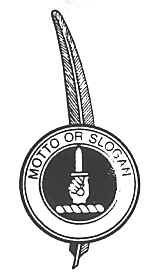 |
(c)
ARMIGERS
i.e. Persons who have registered
their own coat of Arms and Crest, or have inherited these
according to the Laws of Arms in Scotland from ancestors who had
recorded them in the Lyon Register.
An armiger may wear his own Crest
as a badge :— EITHER simpliciter, on its Wreath, Crest Coronet
or Chapeau, OR, as is more usual, within a plain circlet
inscribed with his Motto.
An armiger is entitled to ONE
silver eagle’s feather behind the circlet, and if he is also a
Peer he may add his appropriate coronet of rank on top of the
circlet. An armiger may also choose to wear instead the Crest
badge of his Chief if the armiger is a clansman, as for CLANSMEN
in Section 5(d) below. |
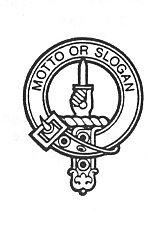 |
(d)
CLANSMEN AND CLANSWOMEN
i.e. The Chief’s relatives,
including his own immediate family and even his eldest son, and
ALL members of the extended family called the "Clan",
whether bearing the Clan surname or that of one of its septs ;
in sum, all those who profess allegiance to that Chief and wish
to demonstrate their association with the Clan.
It is correct for these to wear
their Chief’s Crest encircled with a STRAP AND BUCKLE bearing
their Chief’s Motto or Slogan. The strap and buckle is the
sign of the clansman, and he demonstrates his membership of his
Chief’s Clan by wearing his Chief’s Crest within it. |
6. NOTES
1. Although the Crest Badge is
purchased by and is therefore owned by the clansman, the heraldic
Crest and Motto on it belong to the Chief and NOT to the clansman.
They are the Chief’s exclusive heraldic property, which the clansman
is only thus permitted to wear.
It is illegal for the clansman to
misappropriate the Chief’s Crest and Motto for any other use of his
own, such as decorating his own silver, writing paper or signet ring,
which anyway would mean that these articles belonged to the Chief who
is the owner of the Crest and Motto on them.
Clan Societies, Officials and clansmen
who have reason to use the Crest Badge on stationery should add
beneath it the words "Crest Badge of a member of the Clan. to
make it clear that the Crest Badge is not being misappropriated by the
Clan Society or official involved. It is the Crest Badge of ALL
clansmen, whether members of Clan Societies or not, and non—members
may not be excluded if they are clansmen.
2. The strap—and—buckle is NOT a
"Garter", and it should NEVER be shown coloured blue with
gold buckle and edgings like the insignium of the Order of the Garter.
Crest Badges are for wear by the clansmen, and as they are made
of silver or white metal they should never be illustrated on paper or
other materials in colour, other than white or silver. Line drawings
should be printed in monochrome. It is the privilege of ladies to wear
the Crest Badge of their Chief as a brooch, usually on the left lapel
of a jacket or equivalent position on a dress, and they may wear it
thus in gold if they choose. Real eagle’s feathers behind the badge
may be worn by those entitled to feathers on appropriate occasions,
e.g. Clan Gatherings. Ladies do not wear feathers behind the Crest
Badge, either real or in metal, unless they are Chiefs, Chieftains or
armigers in their own right.
3. Strictly speaking, membership of a
Clan goes with the surname. And so it does NOT pass through married
women who take their husbands’ surnames and do NOT therefore
transmit their own Clan surname to their children. The children are
members of their fathers’ Clans. But many people who have no
paternal Clan of their own are content to demonstrate their
relationship with their mother’s Clan by wearing the Crest Badge of
a clansman of her ancestral Clan. Few Clans would be so strict as to
reject such affiliation, but some Clan Societies do.
4. When surnames were generally adopted
in Scotland in the 17th century, some families took the surname of
their Chief, not always spelling it in the same way, as spellings were
not yet firmly fixed. Some took descriptive names, such as ROY which
means RED, or trade names such as SMITH, WRIGHT, FLETCHER and MILLER.
Their descendants cannot expect to find Chiefs for such derivative
names, but must search back in their ancestry to discover in which
Clan their family originated, as every Clan would have had its own
smiths, wrights, fletchers (arrow—makers) and millers — and
redheads.
5. Many established and reputable Clans
do not have a Chief, where the Chief’s line has died out or been
lost — possibly through long past emigration of the line who are now
heirs to the Chief ship. No Chief can exist for such Clans till a
claimant comes forward and proves to the Lord Lyon King of Arms that
he is the senior heir, when the Lord Lyon will Officially
Recognise him as the Chief.
In some such cases, the Arms and Crest
of a former Chief are known from past records, though not the present
Chief. His clansmen may wear the Crest Badge of the last known Chief,
which would be the same as that of his present undiscovered successor.
In some cases there is no such record, and the clansmen have no Crest
Badge for their Chief at all, nor will have until a Chief is
discovered.
6. Although the illustrations in this
leaflet of Crest Badges for Chieftains and armigers show the same
"notional" Crest within the circlet as for Chiefs and
clansmen, these are of course intended to represent their own personal
Crests, NOT their Chiefs’.
|

